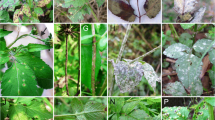Abstract
The genusVerticillium is divided into four sections (two new) and a residual group. The new sectionNigrescentia comprises the well-known plant-pathogenic and some other saprophytic species with dark resting structures. The new sectionAlbo-erecta is characterized by white (or yellowish) colonies and erect conidiophores and contains mainly fungicolous species. Seven (two new) species and two new varieties are described and keyed out. Three other species have known teleomorphs ofNectriopsis (one new and two new combinations). This genus had been merged withNectria by Samuels, but its retention is justified, as the original and the here described fungicolous (and myxomyceticolous) species are more suitably accomodated inNectriopsis than inHypomyces.
The common causal agent of dry bubble inAgaricus bisporus, Verticillium fungicola var.fungicola, is redescribed and defined more narrowly than by Gams (1971) by its maximum growth temperature below 27°C. A similar fungus with a maximum growth temperature near 33°C, causing brown spots inA. bitorquis, is described asV. fungicola var.aleophilum. Isolates from wild agarics with a strongly reduced growth at 24°C and a maximum below 27°C, a yellowish mycelium and inconspicuous sclerotia, are described asV. fungicola var.flavidum. V. biguttatum W. Gams,sp. nov., with cylindrical biguttulate conidia, is a common soil fungus and hyperparasite ofRhizoctonia solani. Gliocladium microspermum (Sacc.) W. Gams,comb. nov., the anamorph ofNectriopsis broomeana (Tul.) W. Gams,comb. nov., which is intermediate betweenGliocladium andVerticillium, is included because of its fungicolous habit.
Samenvatting
Het geslachtVerticillium wordt onderverdeeld in vier secties (waaronder twee nieuwe) en een restgroep. De nieuwe sectieNigrescentia bevat onder meer de bekende ziekteverwekkende soorten met donkere ruststructuren. De nieuwe sectieAlbo-erecta wordt gekarakteriseerd door witte (of geelachtige) kolonies en rechtopstaande conidioforen en bevat hoofdzakelijk op andere fungi groeiende soorten. Zeven soorten (waaronder twee nieuwe) en twee nieuwe variëteiten worden beschreven en in een sleutel verwerkt. Drie andere soorten bezitten perfecte vormen vanNectriopsis (waaronder één nieuwe en twee nieuwe combinaties). Dit geslacht werd door Samuels metNectria samengevoegd, maar kan gehandhaafd worden en lijkt beter geschikt om de hier beschreven ascomyceten onder te brengen danHypomyces.
Verticillium fungicola var.fungicola, de algemene veroorzaker van droge mollen bij de champignon (Agaricus bisporus), wordt beschreven en met zijn temperatuur-maximum beneden 27°C nauwkeuriger gedefiniëerd dan in een vroegere studie (Gams, 1971). Een vergelijkbare schimmel met een temperatuurmaximum van ongeveer 33°C, die bijA. bitorquis bruine vlekken veroorzaakt, wordt beschreven alsV. fungicola var.aleophilum. Isolaten van wilde paddestoelen met een optimum duidelijk beneden 24°C en een maximum beneden 27°C, geelachtig mycelium en onopvallende sclerotiën, worden beschreven alsV. fungicola var.flavidum. V. biguttatum W. Gams, sp. nov., met cilindrische, biguttate conidiën, is een algemene grondschimmel en hyperparasiet vanRhizoctonia solani. Gliocladium microspermum (Sacc.) W. Gams, comb. nov., de imperfecte vorm vanNectriopsis broomeana (Tul.) W. Gams, comb. nov., een tussenvorm tussenGliocladium enVerticillium, wordt opgenomen wegens zijn voorkomen op vruchtlichamen van de dennemoorder.
Similar content being viewed by others
References
Arnold, G.R.W., 1970. (Preliminary survey of mycophilic fungi in the SSSR). Nov. Sist. niz. Rast. 7: 108–120.
Barron, G.L., 1980. Fungal parasites of rotifers: two new verticillate endoparasites with aerial conidiophores. Can. J. Bot. 58: 432–438.
Bollen, G.J. & Zaayen, A. van, 1975. Resistance to benzimidazole fungicides in pathogenic strains ofVerticillium fungicola. Neth. J. Pl. Path. 81: 157–167.
Carey, S.T. & Rogerson, C.T., 1976. Taxonomy and morphology of new species ofHypocrea onMarasmius. Brittonia 28: 381–389.
Dieleman-van Zaayen, A., 1975.Agaricus bitorquis en mollen. Jversl. Proefstn Champ. cult. 1974: 20.
Domsch, K.H., Gams, W. & Anderson, T.-H. 1980. Compendium of soil fungi. Academic Press, London, 859 + 405 pp.
Gams, W., 1971.Cephalosporium-artige Schimmelpilze (Hyphomycetes). G. Fischer, Stuttgart, 262 pp.
Gray, D.J. & Morgan-Jones, G., 1980. Notes on Hyphomycetes XXXIV. Some mycoparasitic species. Mycotaxon 10: 375–404.
Greuter, W., 1981. XIII International Botanical Congress: mail vote and final Congress action on nomenclature proposals. Taxon 30: 904–911.
Holmes, J., Cole, H. jr. & Wuest, P.J., 1971. Contro of theVerticillium disease of the cultivated mushroom,Agaricus bisporus, with benomyl spray applications to cased trays. Pl. Dis. Reptr 55: 684–687.
Isaac, I., 1967. Speciation inVerticillium. A. Rev. Phytopath. 5: 201–222.
Jager, G., Hoopen, A. ten & Velvis, H., 1979. Hyperparasites ofRhizoctonia solani in Dutch patato fields. Neth. J. Pl. Path. 85: 253–268.
Müller, E. & Arx, J.A. von, 1962. Die Gattungen der didymosporen Pyrenomyceten. Beitr. KryptogFlora Schweiz. 11 (2): 922 pp.
Poppe, J., 1972. Un excellentAgaricus tétrasporique cultivable commercialement avec succès. Mushr. Sci. 8: 517–525.
Samuels, G.J., 1973. The myxomyceticolous species ofNectria. Mycologia 65: 401–420.
Samuels, G.J., 1976. A revision of the fungi formerly classified asNectria subgenusHyphonectria. Mem. N. Y. bot. Gdn 26 (3): 126 pp.
Samuels, G.J. & Rossman, A.Y., 1979. Conidia and classification of the nectrioid fungi. In: ‘The whole fungus’ (B. Kendrick, ed.) 1: 167–182.
Subramanian, C.V., 1971. Hyphomycetes. An account of Indian species, exceptCercosporae. ICAR, New Delhi, 930 pp.
Upstone, M.E. & Carter, M.A., 1979. The occurrence ofVerticillium psalliotae onAgaricus bitorquis in Surrey. Mushr. J. 73: 38–40.
Zaayen, A. van, 1981a. Onderzoek naar gedrag en bestrijding van pathogene en concurrerende schimmels in de champignonteelt. Jversl. Proefstn Champ.cult. 1980: 16–19.
Zaayen, A. van, 1981b.Verticillium sp., a pathogen ofAgaricus bitorquis. Mushr. Sci. 11(1): 591–595.
Zaayen, A. van & Gams, W., 1982. Contributions to the taxonomy and pathogenicity of fungicolousVerticillium species. II. Pathogenicity. Neth. J. Pl. Path. 88 (in press).
Zaayen, A. van & Pol-Luiten, B., van der, 1977. Heat resistance, biology and prevention ofDiehliomyces microsporus in crops ofAgaricus species. Neth. J. Pl. Path. 83: 221–240.
Zaayen, A. van & Rutjens, A.J., 1981. Thermal death points for twoAgaricus species and for the spores of some major pathogens. Mushr. Sci. 11(2): 393–402.
Author information
Authors and Affiliations
Rights and permissions
About this article
Cite this article
Gams, W., Van Zaayen, A. Contribution to the taxonomy and pathogenicity of fungicolous Verticillium species. I. Taxonomy. Netherlands Journal of Plant Pathology 88, 57–78 (1982). https://doi.org/10.1007/BF01977339
Accepted:
Issue Date:
DOI: https://doi.org/10.1007/BF01977339




